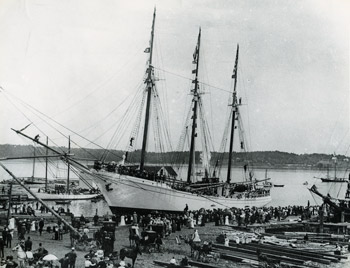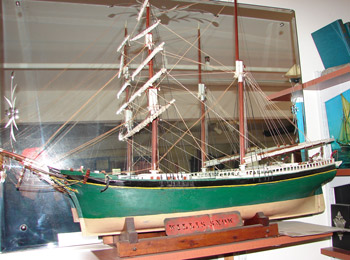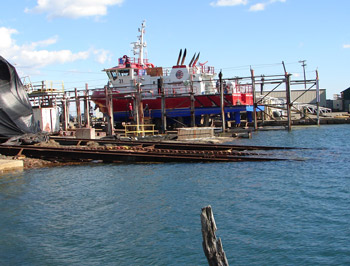Snow’s Point Shipyard
by Tom Seymour

Launch of the Hugh de Payens, Snow’s Point Shipyard, 1910. The 416-ton Hugh de Payens was 148' x 36' x 10.1'. Two- and three-masted schooners were the stock and trade at Snow’s where hundreds were built. Photo courtesy Rockland Historical Society
Persons launching their boat at Rockland Public Landing would probably be amazed to learn that just north of the current boat landing sat the busiest shipyard in the State of Maine and the City of Rockland.
It’s true that more vessels were launched in Bath, Maine, but these were from different yards and, therefore, the total of vessels launched represented the combined number launched in Bath. As per any individual shipyard, Snow’s Point held the record of vessels launched.
Let’s digress a bit and consider what Rockland looked like in the mid-to late-19th century. A visitor coming to Rockland by sea would be met with a floating forest of masts. There were that many commercial vessels in the harbor. And, in fact, the masts in these vessels were about the only upright, tree-like objects in view, since all the wood to a distance of 20 miles inland was long ago cut to fuel the lime kilns.
This was during the heyday of the lime industry and, at one point, 150 kilns burned day and night, the length of the harbor. Imagine the nighttime scene of smoke and flame. And to fuel these ever-hungry lime kilns, the operators, out of necessity, bought firewood. This came from everywhere and most of it was transported by sailing vessel and unloaded at different points on the harbor. Roads and highways at that time were few, unpaved, and inadequate. Therefore, commerce depended upon transportation by water.
Rockland, in the late 1800s, was the fourth largest seaport in the United States in terms of production and commerce. The Rockland Breakwater was built in order to protect shipping. In those days, the lighthouse keeper at the Breakwater Light was unable to count the vessels in the harbor, there were so many.
Family Business
Snow’s Point Shipyard was begun by Captain Israel Snow during the height of the Civil War, 1863. Captain Snow passed the business on to his son and that process continued until 1946, when Snow’s Point Shipyard became the property of General Seafood. Then, in 1957, General Seafood changed hands and the place was taken over by National Sea Products. Finally, in 1991, the yard became property of Rockland Marine, which still operates on the site of the old Snow’s Shipyard.
Over the years, Snow’s Point Shipyard gained not only fame, but also trust. The yard had a sterling reputation and a good name. It was commonly said that a “Snow’s vessel would always get you home.” This was no small thing, either. In the 19th century, many farmers, especially those living along rivers, built boats in winter, as much for something to do as for any profit made. These were often hastily constructed and none-too-solid.
These homemade vessels were used in the spring to carry wood to fuel the kilns in Rockland. One account tells about a wood-hauling vessel that made it to the harbor in such bad shape that its cargo, a load of firewood, was all that kept it afloat.
Snow’s vessels, however, were of the best manufacture and the Snow yard took the extra care to season the wood to be used in building vessels by soaking in a salt pond for up to one year. The pond was dug on the grounds of the shipyard and the water was laced with salt. This permeated the wood and when wood had acquired a sufficient saline composition, it was then considered preserved enough to use for shipbuilding.
But even that was not enough for Snow’s. The shipyard had a process called, “salting a new boat.” Here, the finished vessel was packed with dry salt between the frames. These were sealed and so the wood in a Snow vessel was more than adequately salted, both inside and out. A Snow-built vessel was a well-built, trustworthy vessel.

Model of the Caroline Gray, last of four brigantines built at Snow’s Shipyard. Launched in1869, the Gray had six different captains in her career. Tom Seymour photo
Snow’s Coasters
Remember that sea of masts that our imaginary visitor to Rockland Harbor in the 1800s saw? These were primarily 2- and 3-masted vessels and they were present in the harbor by the thousands. These smaller, sturdy vessels were Snow’s Point Shipyard’s stock in trade. Larger vessels, 6-masted ones, for example, could not get into small ports because they were far too large to turn around. It was the smaller, workhorse vessels such as those built at Snow’s Point Shipyard that did the lion’s share of trade and figured so prominently in commerce.
In a day when there were no long-haul trucks and no interstate highways for those trucks to travel on, small-to-medium sailing vessels were responsible for moving goods from one point to another. These “coaster” vessels were ubiquitous along the entire east coast. And no matter where you went, you were sure to see a vessel built at Snow’s Point Shipyard in Rockland, Maine.
These 2- and 3-masted vessels hauled anything and everything, from wood to coal. Whatever came ashore at any port in Maine usually came on a vessel such as this. The days of sailing vessels were soon to end, though, as steam power displaced wind power.
The last sailing vessel built and launched at Snow’s Point Shipyard slid down the ways in 1920 amid a great crowd of onlookers and onboard participants. Smoke billowed out from the ways as the vessel made her way to the water, adding to the pageant and fanfare. The smoke, by the way, was caused by burning pig fat. In those days, the ways, or rails, were greased with pig fat in order to allow a vessel to slide along without binding. But even at that, the weight of a sailing vessel was such that friction built up to the point that the pig fat usually ignited.
A photo of the launching clearly indicates a new keel, built near and just above the stays where this last vessel slid to sea. It was considered good luck to lay a new keel upon launching a vessel. This was in the spirit of continuity, meaning that the process was a never-ending one.
But alas, in 1926, that same vessel that was launched on smoking stays, the one that carried with it so much hope for the future, was cut up for scrap at Snow’s Point Shipyard. This marked the beginning of the end of an era.

Ways at Rockland Marine are from the original Snow’s Shipyard on the site. Tom Seymour photo
End Times
The First World War gave Snow’s Point and, indeed, most other shipyards, a brief boost. Ship repair and so on for the military gave shipyard workers employment for as long as the war lasted. But even this was but a last, burning ember of a great fire that was to eventually burn out.
In between wars, the shipyard had to look far and wide in order to keep its crew busy. In 1934, Snow’s Point Shipyard built two yachts. But that was nothing more than a stopgap measure.
In order to try to keep up with the times, Snow’s Point Shipyard even built a few steam-powered vessels. At least two of these are documented, but it is possible that more were built. Half-models of the two documented powerboats are preserved at the Sail, Power & Steam Museum at Sharp’s Point in Rockland. The museum and outlying buildings sit between Rockland Public Landing and Rockland Marine, on the site of the original Snow’s Point Shipyard.
These half-models were fashioned by hand, often with a skilled hand holding a sharp knife and soft piece of pine. Once completed, builders could refer to the model and make their plans from there. Such models are rare, in that few survive. The half-models of the two power vessels mentioned here are valuable treasures from Maine’s maritime past.
World War II again gave shipbuilding and repair a boost, but that, too, was only postponing the inevitable. Snow’s Point Shipyard was officially no more when it changed hands in 1946 and became General Seafood.
Many thanks to the Sail, Power & Steam Museum for supplying data and photos for this article.
